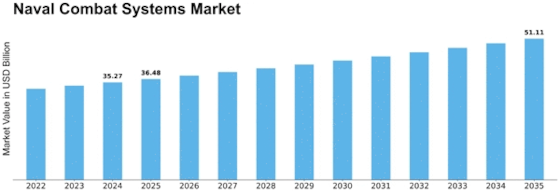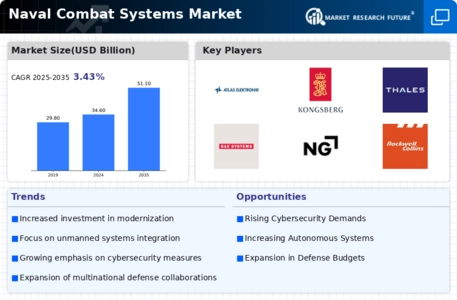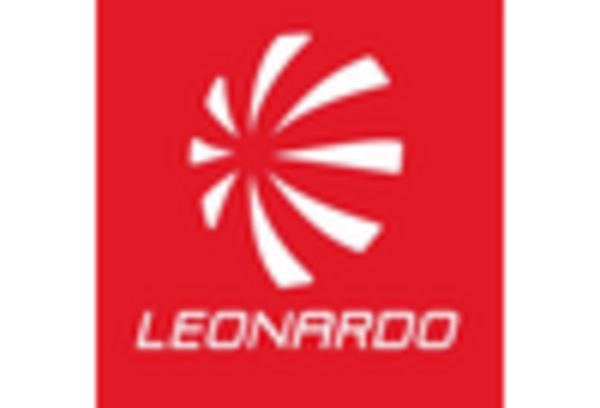Naval Combat Systems Size
Naval Combat Systems Market Growth Projections and Opportunities
The Naval Combat Systems market is characterized by dynamic forces that shape its growth, evolution, and overall landscape within the defense sector. One of the key dynamics driving this market is the continuous technological advancements in naval warfare capabilities. As nations seek to enhance their maritime security and naval dominance, the development and integration of cutting-edge combat systems become imperative. These systems encompass a wide array of technologies, including sensors, communication systems, missile defense, and electronic warfare, contributing to the sophistication of naval forces globally. The relentless pursuit of technological superiority influences the competitive dynamics and market trends within the Naval Combat Systems sector.
Geopolitical considerations significantly impact the market dynamics of Naval Combat Systems. Maritime powers worldwide are engaged in continuous efforts to strengthen their naval capabilities, driven by strategic interests, regional tensions, and the evolving nature of global security threats. The geopolitical landscape shapes procurement decisions, naval strategies, and the overall demand for advanced combat systems. The dynamics are influenced by the need for naval forces to adapt to emerging challenges and assert their presence in strategically significant regions.
Budget allocations and defense spending play a crucial role in the market dynamics of Naval Combat Systems. Governments and defense agencies allocate budgets to enhance their naval capabilities, including the acquisition and modernization of combat systems. The dynamics of the market are influenced by the financial commitments of nations to maintain and upgrade their naval fleets, reflecting the prioritization of maritime security within overall defense strategies.
The emphasis on naval modernization and fleet expansion is a driving force in the market dynamics. As navies worldwide seek to maintain a technological edge, there is a continuous demand for advanced combat systems that offer improved situational awareness, command and control capabilities, and interoperability. The dynamics are shaped by the need for naval forces to upgrade their existing platforms and integrate state-of-the-art technologies into new vessels, ensuring a comprehensive and effective naval combat capability.
Technological convergence is a significant dynamic within the Naval Combat Systems market. The integration of diverse technologies, such as artificial intelligence, unmanned systems, and advanced sensors, contributes to the development of more sophisticated and multifunctional combat systems. The dynamics are influenced by the synergies created through the convergence of technologies, enhancing the overall capabilities of naval forces and shaping the landscape of future naval warfare.
Research and development (R&D) investments are pivotal in driving the market dynamics of Naval Combat Systems. Defense contractors and technology providers invest in R&D initiatives to innovate and develop cutting-edge solutions. The dynamics are shaped by the competition among industry players to introduce advanced technologies, ensuring that naval combat systems remain at the forefront of innovation. R&D investments contribute to the evolution of capabilities, addressing emerging threats and challenges faced by naval forces.
The evolving threat landscape, including anti-access/area denial (A2/AD) capabilities, asymmetric threats, and cyber threats, significantly influences the market dynamics. Naval Combat Systems are designed to counter these threats, offering capabilities such as advanced missile defense systems, electronic warfare solutions, and cyber resilience. The dynamics are shaped by the need for naval forces to adapt and respond effectively to diverse and evolving security challenges in maritime environments.
International collaborations and partnerships are key dynamics in the Naval Combat Systems market. Given the complexity and cost of developing advanced combat systems, countries often engage in collaborative efforts to pool resources, share expertise, and jointly develop naval capabilities. The dynamics are influenced by the partnerships among nations and defense contractors, contributing to the creation of interoperable and standardized combat systems that can be adopted by multiple naval forces.
The dynamics of competition and market consolidation also play a crucial role. As defense contractors vie for contracts and seek to establish market dominance, there is ongoing competition to offer superior and cost-effective Naval Combat Systems. The dynamics are shaped by industry mergers, acquisitions, and strategic alliances that aim to strengthen market positions and enhance overall competitiveness within the naval defense sector.
Environmental considerations and the rise of unmanned systems contribute to the dynamics of Naval Combat Systems. Navies are increasingly integrating unmanned platforms for various purposes, including reconnaissance, mine countermeasures, and anti-submarine warfare. The dynamics are influenced by the adaptation of naval combat systems to incorporate unmanned technologies, allowing for more flexible and versatile naval operations in different environments.


















Leave a Comment